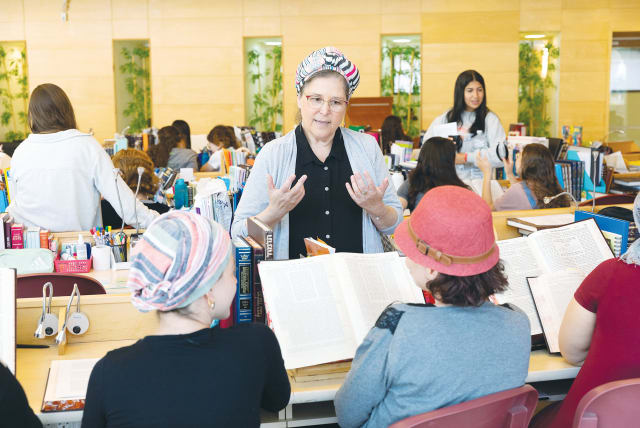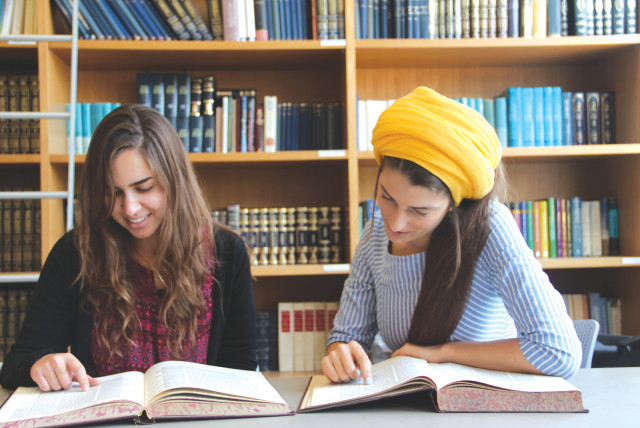It's time to acknowledge women's Torah knowledge - opinion

The High Court of Justice ruling is significant in that it is a critical recognition of women’s education, knowledge, and integration into the sphere of Torah and Halacha.
Over 100 years since the first assembly to elect the chief rabbis of Israel was convened, the High Court of Justice has ruled on the appointment of women to the Chief Rabbinate’s electoral body in slots reserved for rabbis.
The High Court ruled that according to existing law, there is no obstacle to the appointment of women to the assembly that elects the majority of the members of the Council of the Chief Rabbinate – provided that they have an appropriate Torah and halachic education. There is no impediment to appointing women who are knowledgeable in Torah and Jewish law to sit at the assembly as “rabbis” in the despite not being ordained.
We live in a time when nearly every day brings news of the significant contributions being made by women. Certainly, we are aware of the heroines on the home front, caring for their families for weeks on end, while their husbands are away, and rising to fill many roles on behalf of a society in pain. We are also witness to women serving on the front lines exhibiting great courage and valor, saving the lives of many – sometimes even paying with their own lives.
It is therefore significant to recognize the accomplishments of women on the “spiritual front.” For the women who entered the sacred gates of the beit midrash years ago, many of whom are extremely well-versed in Jewish law and serve as halachic leaders, the High Court of Justice ruling is significant in that it is a critical recognition of women’s education, knowledge, and integration into the sphere of Torah and Halacha.
It is important to understand that although the initial ordinances related to electing the Chief Rabbinate of Israel stipulated that all the members of the electoral assembly must be men, the High Court of Justice ruled as early as 1988 that women may not be excluded from the electoral body (in a petition that dealt with the assembly for the election of the rabbi of a city). In practice, women have served on the assembly charged with electing the chief rabbis for years, albeit in relatively small and insufficient numbers. Recent years have seen an attempt to address the underrepresentation of women in this assembly through the appointment of 10 public figures who are women (representatives appointed by the religious services minister).
Now, however, the heart of the issue is not the focus on female representation per se, but rather a larger question of who can fall under the expanded category of “rabbis” in the electoral assembly, based on their Torah education and proficiency in halacha.
If we go back to the days before the establishment of the state, chief Rabbi Abraham Isaac Kook urged that the chief rabbi be chosen by an electing assembly made up exclusively of rabbis. Ultimately, a compromise was reached, which divided the composition of the electoral body into a large majority consisting of rabbis and a small minority of public representatives. Over the years, the ratio between the two parts of the electoral assembly has been altered but the rabbinic majority maintained.
Women are a critical part of the world of Torah
A century has passed and today, women are a critical part of the world of Torah and Jewish legal discourse. While women are unable to take the official rabbinical ordination exams, for many years already there have been educational institutions offering women intensive halachic studies conducted at the highest of levels and with commensurately high-level exams. Over a year ago, for the first time, the Religious Services Ministry held examinations to assess the halachic knowledge of such program participants, and certificates were awarded to the 15 women who passed.
Despite this, the majority of seats in the electoral assembly designated for “rabbis” remain irrelevant for women, because they are reserved for people serving as city, community, or council rabbis – positions requiring ordination and thus held exclusively by men. The ruling of the High court of justice specifically addresses this, determining that there is no barrier for women to nonetheless be included under this designation. This ruling is an important and clear statement by the court that halachic Torah education not obtained through the rabbinate can still be recognized, giving de facto acknowledgment to the educational settings where women have been studying.
This recognition is part of a long grassroots process. It began with trailblazing women who took their place in the beit midrash and engaged in the study of Talmud and Halacha despite their learning not being acknowledged and despite having no indication of where it would lead. They pursued this path simply because they were motivated by an inner passion and desire to understand Halacha, and they acquired vast knowledge through their diligent efforts and commitment.
And then, recognition grew among the grassroots – initially in educational institutions and later among the public, when people started turning to these women with halachic queries, alongside communities and synagogues that began to incorporate them into spiritual and halachic leadership roles. Now we are witnessing the next crucial step in making women scholars an integral part of the public and religious fabric: recognition by the establishment.
After more than a decade of women being trained in Jewish law, we are seeing the beginnings of an intersection between what is happening in the field and the establishment – the appointment of women to lead religious councils, funding for women spiritual leaders in communities, halachic examinations for women offered by the Religious Services Ministry and now, this ruling by the High Court of Justice. We hope that these steps will open doors for women to serve the state in diverse and adequately compensated religious positions.
We understand that the ruling will not result in the widespread appointment of women halachic leaders to the electoral body since there is no requirement to appoint a minimum number of women. Nevertheless, the court, through its ruling, has established a crucial foundation for future potential advancements. While such changes may not occur under the current coalition, they could materialize through legislation in a future Knesset that mandates the integration of women.
During this time, as we unite in our efforts and prayers for the soldiers, the return of our hostages, and the speedy recovery of our wounded, while mourning the fallen, the court has provided us with yet another avenue to examine the partnership and involvement of everyone – women and men alike.
The writer, a rabbanit, is director of Ohr Torah Stone’s Susi Bradfield Women’s Institute of Halakhic Leadership (WIHL) and campus spiritual adviser at Bar-Ilan University.
Jerusalem Post Store
`; document.getElementById("linkPremium").innerHTML = cont; var divWithLink = document.getElementById("premium-link"); if (divWithLink !== null && divWithLink !== 'undefined') { divWithLink.style.border = "solid 1px #cb0f3e"; divWithLink.style.textAlign = "center"; divWithLink.style.marginBottom = "15px"; divWithLink.style.marginTop = "15px"; divWithLink.style.width = "100%"; divWithLink.style.backgroundColor = "#122952"; divWithLink.style.color = "#ffffff"; divWithLink.style.lineHeight = "1.5"; } } (function (v, i) { });

